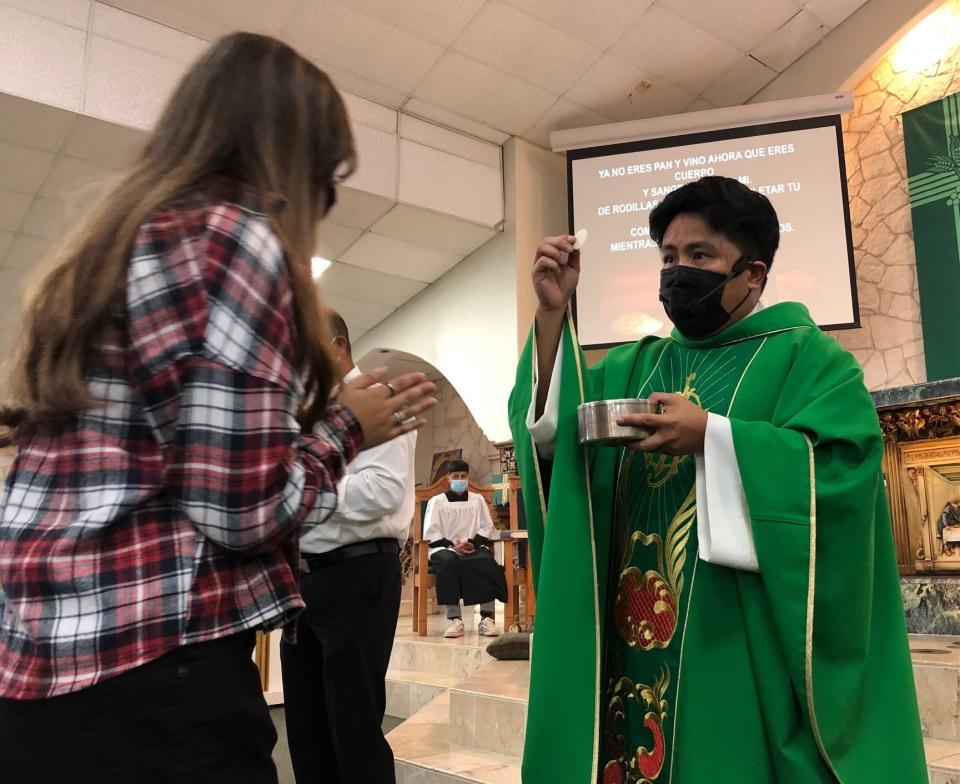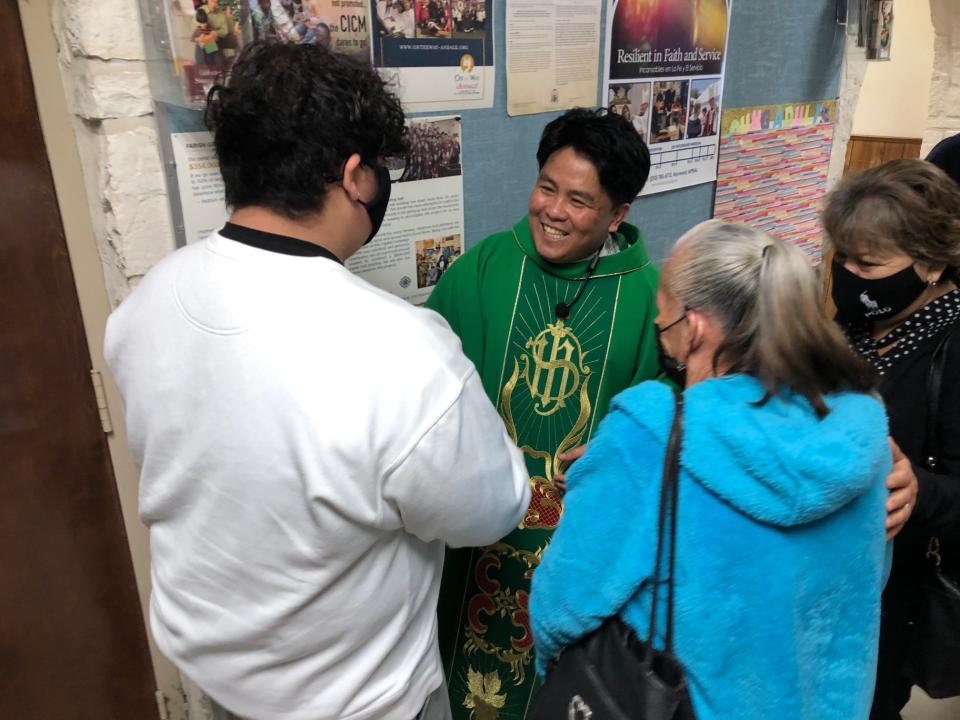Latino Catholics have one of the highest COVID-19 vaccination rates in the US
SAN ANTONIO – There were many dark days over the past year at Divine Providence Catholic Church, when the coronavirus ravaged families, and funerals outnumbered Bible studies. Parish leaders counted 54 COVID-19-related deaths among its predominately Latino congregants. The church stood nearly empty for more than a year, as the pandemic kept many parishioners at home.
Last Sunday, however, more than 200 parishioners filled the pews, most of them masked and a majority vaccinated against the deadly virus. They swayed to Spanish-sung hymns and lined up for communion.
The Rev. Ryan Carnecer, the parish pastor, said the church’s strong embrace of COVID-19 vaccines has been a major reason for its rapid return to normalcy.
“Covid was so real for us. There were deaths,” said Carnecer, who is Filipino and gives mass in fluent Spanish. “I told them, ‘Please vaccinate.’ I’m so grateful they followed.”

Latino Catholics – such as those at Divine Providence – have one of the highest COVID-19 vaccination rates among major religious groups in the United States, according to a recent Pew Research Center survey. The study of 10,000 adults revealed that 86% of Hispanic Catholics said they were at least partially vaccinated, higher than white Catholics (79%) and second only to atheists (90%). Overall, about 79% of all U.S. adults are partially vaccinated, according to the Centers for Disease Control and Prevention.
The study comes amid ongoing debate over whether to mandate vaccines, and amid ethical questions surrounding the research and manufacture of certain vaccines using cell lines from aborted fetuses.
Catholic Church leaders, though strongly opposed to abortion, have taken differing positions on vaccine mandates and the use of religious exemptions.
A letter by four Colorado bishops in August declared support for some COVID-19 vaccines, but strongly opposed mandates.
“The vaccination question is a deeply personal issue, and we continue to support religious exemptions from any and all vaccine mandates,” the letter said.
COVID-19 vaccine: Does natural immunity or vaccination protect you better from the coronavirus?
By contrast, the archdioceses of New York, Los Angeles and Philadelphia have urged their priests not to provide religious exemptions to vaccines.
Tadeusz Pacholczyk, director of education at the National Catholic Bioethics Center, a research center in Philadelphia, said vaccine hesitancy among Catholics stemmed less from concerns over aborted fetal cell lines and more from fears over the speed in which the vaccines were developed and general mistrust of government and pharmaceutical companies.
The Bioethics Center has posted information to help readers reach a decision and advocated against vaccine mandates that don’t allow for some exemptions, he said.
“There’s still quite a bit of polarization, quite a bit of discussion,” Pacholczyk said. “It reflects society at large … Differences outside the Catholic Church are also seen inside the Catholic Church.”

Hispanic Catholics harbored concerns over vaccines earlier this year, but their outlook sharply changed by the summer. Acceptance of vaccines by Latino Catholics jumped from 56% in March to 80% in June – the most dramatic increase of any religious group, according to surveys by the Public Religion Research Institute. At various points throughout the pandemic, Latinos experienced the second-highest number of COVID-19 deaths, trailing Black Americans or American Indians and Alaska Natives.
Vaccines got a major boost in August when Pope Francis, along with six U.S. and Latin American archbishops and cardinals, put out a video supporting anti-COVID-19 inoculations. In the three-minute video, in Spanish with English subtitles, the pope called getting the vaccine “an act of love” and urged his followers to immunize against the deadly virus. The video on YouTube has gotten 2.6 million views.
“Getting vaccinated is a simple yet profound way to care for one another, especially the most vulnerable,” said the pope, the church's first Latino pontiff.
The message resonated among Catholics, especially those in the Latino community who had been hard hit by the pandemic, said Gustavo García-Siller, archbishop of San Antonio. One parish in his diocese had 95 funerals last year, many of them linked to COVID-19, he said.
Earlier this year: As COVID-19 vaccine mandates grow, so are requests for religious exemptions
García-Siller partnered with local health groups and leaders to organize vaccination drives and pop-up clinics in churches across the city. The efforts paid off: San Antonio health officials last week announced that the city, which is 64% Hispanic and strongly Catholic, had counted 76% of vaccine-eligible residents as fully vaccinated and 91% having received at least one shot.
“We need to be responsible … to be co-responsible for the safety of one another, to go beyond personal preferences and focus on the common good,” García-Siller said. “The results have been better than we thought.”
Ramon Samaniego, 45, a parishioner at Divine Providence church, said he was shaken when three people at the construction company he works for contracted the coronavirus. When a vaccine became available to him in early March, he jumped at the chance.
“I got it to protect myself, to protect my family,” Samaniego said.
Carnecer said COVID-19 besieged his parish, which is 98% Hispanic. Dozens of parishioners, many of them hospitality or construction workers with poor access to health care, caught the virus, he said. Funerals became commonplace, even as the church remained empty. In December, he himself caught the virus, quarantined and recovered.
When a vaccine became available in February, Carnecer and a fellow priest at Divine Providence got the shot and later posted pictures of the event on his Facebook page. Some white and Filipino acquaintances from his former parish in North Carolina attacked him, saying the church shouldn’t encourage vaccines, he said. Hispanic parishioners from San Antonio mostly applauded him.
From his pulpit, Carnecer urged parishioners to vaccinate. When he noticed vaccination efforts were mostly focused in the central or north parts of the city, where fewer Latinos live, he teamed with local community groups to launch vaccination drives in the parking lot of his South San Antonio church. Over three events, more than 600 people were vaccinated.

Church leaders urged parishioners to get vaccinated before attending mass in person – leading to a surge in vaccinations among attendees eager to return to Sunday mass, said Lilia Rodela, the church’s pastoral council president. Carnecer’s vocal support of the vaccine and getting the shot early helped motivate many parishioners, she said.
“If it’s coming from Father Ryan, it’s a good thing,” Rodela said.
Today, Carnecer estimates that the majority of his 500-person parish is vaccinated, and masses have returned to about 90% of pre-pandemic attendance.
He said he still occasionally hears from parishioners who are hesitant to get vaccinated because of the stem cell debate or other reasons. Another hurdle: Mexican priests who oppose the inoculations and whose comments reach the social media pages of San Antonio congregants.
To those who still have doubts, Carnecer reminds them of the year they’ve been through and what the church looks like today.
“No one’s getting sick” in his parish, he said. “In other words, vaccines work.”
Follow Jervis on Twitter: @MrRJervis.
This article originally appeared on USA TODAY: COVID vaccination rates rise among Latino Catholics after deadly year

